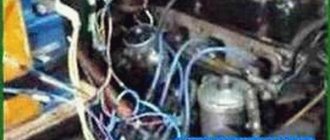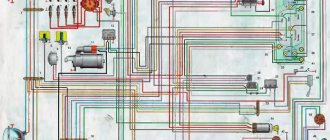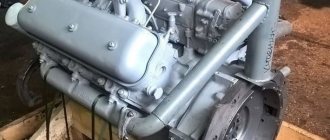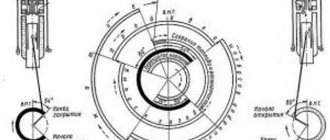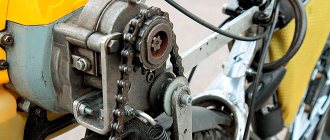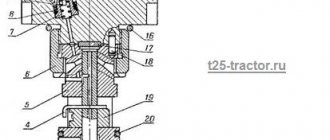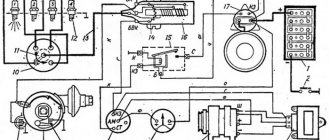Technical characteristics of the ZIL-157 truck and its best modifications
The ZIL-157 can now be seen more in movies than on the roads of the country, although the car has become not only a source of pride for the Likhachev plant, but also for the entire Soviet automobile industry. The history of its creation began in 1954, when the Stalin plant began developing a 3-axle all-wheel drive truck for army needs.
The army needed powerful and reliable technology. The ZIS-151, which appeared in the post-war years, could no longer cope with the tasks, but was taken as the basis for the creation of a new Soviet truck. The new ZIL was put into mass production already in 1958. The car was perfect for the 60s. This was recognized in the world (Grand Prix at an international exhibition) and in the Soviet Union (it was used not only in the army, but also in the national economy).
Recent Entries
The second end is connected to the next one, and in this way every last one is connected. Distributor sensor: 1 - distributor cap; 2 - coal; 3 — cover spring; 4 - low voltage connector; 5 - weight; 6 — spring of the centrifugal machine; 7 - weight axis; 8 — thrust bearing; 9 — roller bearing; 10 - coupling; 11 — roller; 12 — octane corrector plate; 13 — body; 14 - ball bearing; 15 — vacuum regulator; 16 - stator; 17 — rotor bushing; 18 - felt; 19 — slider The device of the sensor-distributor is shown in Fig. Layout of the DC switch chip on Dio 34
Interior and exterior
The cabin was borrowed from the ZIS that became the prototype, it was improved, but everything else in the truck underwent a radical alteration. The defense order was fulfilled taking into account the army load, so all the features of the new truck are associated with increased endurance, maneuverability and reliability.
Externally, the car began to look harmonious: an elongated and slightly pointed “nose”, wide flat fenders, 6 single-pitch wheels, round headlights on the side wings, protected by a metal grille. In the steering, the designers installed shortened bipods to reduce the force of impacts transmitted to the hands, telescopic shock absorbers increased the smoothness of the ride, a water radiator with an electric motor was supplemented with a windshield blowing system, and new seats were made with adjustment.
The car body was a wooden platform covered with longitudinal metal ribs that protected it from abrasion. The sides were assembled from wooden plates 20x80 mm. The front side was fixedly attached, and the sides and rear were folded back, completely opening the body platform.
There are 2 fuel tanks - 150 l and 60 l; when fully refueled, the car can cover more than 500 km.
Cabin and body
The model had body sides with the ability to open on three sides, which facilitated the loading/unloading process. The ZIL-157 gained particular popularity in the Soviet army due to its cross-country ability and high endurance levels - this explains its widespread use.
In the cabin of the previous model, the driver could not count on comfortable work; the seating position was uncomfortable, there was no heater, and ventilation was poor. In addition, the driver's hands were subject to noticeable impacts transmitted from the wheels.
On the new truck, the designers tried, if not to completely get rid of the shortcomings, then at least partially improve the ergonomics of the cab and steering. The driver's seat, characterized by a comfortable fit, is adjustable.
Over the years of production, the ZIL-157 cabin has undergone minor changes, while maintaining the original characteristics. It was an all-metal structure and allowed free space for the driver and two passengers.
There was a round hatch on the roof. The list of items on the all-terrain truck's instrument panel included a turn switch, windshield wiper valve, radiator shutter control handle, brake and tire pressure gauges, and a small instrument panel. The speedometer took pride of place on the larger dial.
Specifications
Over the long (from 1958 to 1991) years of production of the ZIL-157, the technical characteristics underwent some changes, which was predetermined by technical progress in the automotive industry. And the basic model, produced from 1958 to 1961, was distinguished by the following data (performance characteristics):
width - 2315 mm;
height - 2360 mm (with awning - 2915 mm)
width - 2090 mm;
Power unit
The modernization of post-war equipment concerned primarily the power unit. Trucks of those years were not very powerful and had a lot of shortcomings. The new car received an innovative 4-stroke carburetor gasoline unit for those times. The 157th diesel engine was not produced on an industrial scale.
With an improved power plant, the ZIL-157's fuel consumption decreased by 7-22% while increasing productivity (the parameter depends on driving conditions).
The overheating problem was eliminated by installing a radiator with a 6-blade fan. The ventilation scheme was completely revised; it was implemented as a closed-cycle crankcase. The modified design of the crankshaft seals has improved the performance of the oil pump. The water pump seals have also been modified.
Installing a new aluminum alloy head on an in-line 6-cylinder block with a displacement of 5.55 liters made it possible to increase the compression ratio to 6.2. The power of the car was 104 hp. at 2600 rpm, after another modernization in 1961 - 109 hp. The engine ran on A-66 gasoline, and after 1978 - on A-72. Fuel consumption per 100 km averaged 42 liters, but expenses depend on the road surface.
Additional characteristics of the power plant:
- torque - 334 Nm;
- cylinder diameter - 101.6 mm;
- firing order - 1-5-3-6-2-4;
- cooling - liquid.
The ZIL engine coped well with the most difficult tasks and started easily even after a long period of inactivity. Problems arose only when working in low temperature conditions, so special casings were included with the machine. Over the years, the problem with maintaining a constant operating temperature was solved, but insulating casings for the radiator remained included in the package.
Transmission
The 5-speed manual transmission initially featured a fifth overdrive gear, but was dropped in 1961. The transfer case device has been improved: new seals and wear-resistant gears have appeared, and the possibility of forced activation has appeared. Clutch - dry, 1-disc. Transfer case ratios: first gear - 2.27, second - 1.16.
The cardan transmission scheme has changed. An intermediate support for the rear axle cardan appeared on the middle axle. High-strength casings were introduced into the drive axles. The front axle was supplemented with hinges with equal angular velocities. The transfer case had 2 reduction gears. The driver has the opportunity to disable the front axle.
Dimensions and wheels
Related industries also worked on the development of a new car. Tire makers have developed special tires to order that allow movement with temporarily reduced air pressure in them. The designers had to reconsider the layout of the new all-terrain vehicle. Instead of the 10 wheels that the ZIS-151 had (plus 2 spares), the new model was equipped with 6 with a tire size of 12.0018 and an air pressure of 3.0-0.5 kgf/cm².
The tire was characterized by increased elasticity, because the number of cord layers was reduced to 8, and soft rubber was used for the inner layers.
To improve off-road performance (swamps, sand, etc.), the driver remotely reduced the tire pressure using a centralized system. The car continued to move at low speed (10 km/h). The truck could continue to move even if a single tire was damaged.
Design and principle of operation of the ZIL 130 starter relay
The vehicle starter is a gear type part. It is a separate and small-sized electric motor that creates the conditions for generating torque at the crankshaft of the machine.
The design of the device provides for the following list of parts:
- Metal body, which is made of strong and durable alloys. The shape and features ensure an ergonomic placement under the hood of the car. A set of contact relays consists of moving and stationary elements.
- Coil and gears.
- Protective cover.
- A screw that regulates the direction and intensity of the gears.
- Lever and special thrust ring.
- Manifold, protective tape and starter cover.
- Shaft.
- Drive couplings and free-wheeling components.
The interaction of this set of components allows motorists not to worry or encounter problems starting the engine in any weather conditions.
Modifications
More than 10 variants were produced on the base 157th ZIL under the following indexes:
- B - truck tractor;
- K - basic version improved in 1961;
- KV - truck tractor, developed in 1961;
- D - option using shielded electrical equipment for protection against radio interference and radar detection equipment;
- KG - modification of 1961 using shielded electrical equipment based on version K;
- KD - a variant from the Ural plant, which received an improved carburetor, appeared in 1978;
- KDV - truck tractor 1978;
- E - special version, equipped with 2 fuel tanks of 150 l each;
- E - transport for delivery to the Warsaw Pact countries;
- Yu is a car with a modified cooling system and a larger radiator for use in tropical climates.
ZIL-157 KDM is an experimental flatbed truck manufactured in 1984 with a ZIL-157KD engine and transmission, a ZIL-130 and ZIL-131 cab, a ZIL-131 frame and platform. But prototypes are not limited to the ZIL-157KDM; for example, in 1962, the ZIL-157KV1 was manufactured - a truck tractor for working with semi-trailers.
Dump truck
The dump truck units of the Mytishchi plant decided to adapt a dump truck on the ZIL-157KD chassis. The prototype ZIL-MMZ-4510 was built in 1988. It received a metal platform with a dump mechanism and a hydraulic pump. Tests revealed a number of problems, as a result, dump trucks were produced in a small batch for army needs.
Timber truck
The timber carrier was not produced serially. However, due to its carrying capacity, the ZIL-157 has found wide use among loggers. The truck is durable, can overcome wetlands and areas with difficult terrain, conscientiously hauling round timber from clearings.
Firefighter
The ZIL hose fire truck was named AR-2. It has an enlarged fire brigade cab and wide rear doors. The fire truck is equipped with a 4.5-ton water tank and a telescopic ladder. Can work in the most difficult to reach places.
Gasoline tanker
ATZ-3-157 is a fuel tanker, which began to be produced back in 1958. In 1959, the VMZ-ZIL-157 army water and oil tanker appeared, in which one tanker was designed for 1400 liters of water, the other for 700 liters of oil. ATsMM-4-157K is a fuel and oil tanker built in 1962 with a capacity of 250 liters of technical oil.
Bus
Based on the chassis of the 157th model, a cabover staff bus was produced for the needs of the Western Group of Forces in Germany.
How to extend the service life of the starter for a car model ZIL 130
Simple but practice-tested tips on how to extend the effective service life of a system without much effort or expense are:
- To prevent the device from overheating - to do this, it is enough to limit the starter operating time to more than 10 seconds.
- All important activities for repairing, restoring or checking the serviceability of the mechanism should be trusted only to professional craftsmen who accurately and thoroughly understand the ZIL 130 starter connection diagrams.
- While the vehicle is moving, it is strictly forbidden to start the starter.
- Immediately stop operating the device after the vehicle engine starts running.
- Do not suddenly start the car from a standstill.
A starter for a ZIL 130 car is a reliable and durable part that is responsible for and ensures prompt, quick starting of the car engine in any conditions.
In order to understand in more detail and accurately the features and rules of connection and operation, you can independently study all the technical parameters of the starter or seek professional help from our specialists.
In general, I want to share the good news: the weight has been lifted from my shoulders - I finished electrical (well, almost finished because there are still a lot of important things to do, instruments, booster pump, etc.) ... I did the wiring from “0”, those who are in the subject will understand that this is it =)
At this stage of the work, we had to implement our ideas for external and internal design. I wanted all the details to be made in the USSR as much as possible, from the lights to the toggle switches. This was mostly achieved, although finding the right parts was sometimes problematic.
But we had to install modern lighting for the room due to the limited space, but it’s not visible, it’s shining and ok!
Separately, I want to say a loud “FI” in the direction of modern Russian manufacturers... BRUGGERS, drive away the outspoken leftist, God forbid a couple of switches from the pack work as they should! In response to my lamentations at the spare parts store, they answered me: “Well, what can I do? I can close and not sell anything at all, will you like that? It’s not me who is making this defect...” The USSR parts also do not shine with quality, although it is quite likely that the USSR parts in them are only body castings... The lights and toggle switches and switches upset me. But what to do - I had to be patient and search, fix, redo so that everything would work as it should.
Conceptually, I saw the design of the torpedo as technocratic and military as possible, like in a combat helicopter, and I wanted to combine a freshly painted Raptor torpedo with deliberately old-school shabby parts, a kind of MadMax)))
The control of all electrical circuits is entrusted to metal toggle switches of different calibers, then the signal goes to switches, which in turn are powered by fuses, and ultimately to the desired electrical appliance.
The abundance of toggle switches and switches can cause culture shock for an unprepared person, so for the first time I made labels and labeled each switch. If necessary, the labels can be removed without damaging the torpedo.
Of the foreign parts, perhaps only the emergency light switch, but without it you can’t go anywhere, excuse me, an attribute of modernity, the “thank you” button should be present))
In Lesorub there will also be a car radio and a socket for connecting, say, a navigator. All this equipment will be hidden in the glove box. The original poor glove compartment is made of cardboard, held together with nails and paper clips, a depressing sight... so I decided to make a new one, which will contain the attributes of comfort
The device itself is in the process of being manufactured, I hope that tomorrow I will finish it and show you)
Apparently, a searchlight was once installed in the ceiling of our donor's cabin. And even in the trunk there was a special cutout for the masset, and a hole in the roof accordingly. We decided not to miss the opportunity, purchased a finder headlight and installed it on the top of the Lumberjack. I powered the finder headlamp and high beam from one toggle switch, which is very convenient for strobe lighting and simaphore, driving away the hamsters that get in the way into a state of horror!)
By the way, as I already wrote, we carefully restored the trunk, patched it up and finally installed it in its rightful place. Such charismatic details cannot be thrown away; even though they are made of wood, they are still from those lamp times!)
As a cookie, catch a mega-informative video demonstrating how everything works =) Details after a pause!
Piaggio commutator coil/ Broke during repair
Reviews and prices
Serial production has long been completed. Now you can only find equipment for sale from the 1980s or 90s. Price for models - from 40,000 rubles.
Vladimir, 55 years old: “From the time of serving in the army, they remember the hands of the cleaver - ZIL-157, its characteristics were the best for those years. Our unit also had other equipment, it could not be compared either in terms of power or cross-country ability.”
Vadim, 36 years old: “I heard about the car from my father and his driver friends. They worked in the Far North, in Kazakhstan, on large construction sites. In conversation the car is called Zakhar. As a child, I thought that this was a brand of truck, and when I grew up, I realized that they call it that out of respect, and all the drivers in the country.”
Appearance
In ignition systems with a variator, the reason is the low reliability of the latter. As for flirting, I can give you an example from life.
And just imagine this picture of a GAZ, let’s say after a year of production, there is, of course, ignition without an additional resistor. The distributor sensor has a housing, a cover, a roller, a sinusoidal voltage sensor, centrifugal and vacuum regulators, as well as an octane corrector.
The use of contact-transistor ignition systems makes it possible to: obtain higher output voltages by increasing the current in the primary winding and reduce the electrical load of the breaker contacts; increase the gap between the electrodes of the spark plugs to O.85...1.0 mm, which makes it possible to work on lean working mixtures and thereby reduce the toxicity of exhaust gases; facilitate starting and increase the reliability of engine operation at low and high speeds; increase the durability of the breaker contacts; reduce average operating fuel costs. Powerful ignition for little money Electrics As you know, few people are satisfied with the standard contact ignition of the Urals and Dnieper.
New blog posts
ZIL 130, ZIL 131, GAZ 3307, GAZ 3102, GAZ 3110, GAZ 53, MAZ 500, T 25, T40, Izh Planet, Izh Jupiter
Replace the switch In the event of pulsed voltage increases, capacitor C2, when charged, prevents overvoltage of the transistor and the flow of large destructive current through it.
While a car ignition works with a spark plug gap of 0.0 mm, because this system has a higher breakdown voltage. Maintenance Check the tightness of the nuts of the low-voltage sensor-distributor connector and the fastening of the connecting wires. Ignition ZIL 4331 part 2
ZIL-157
- Car make: ZIL
- Country of origin: USSR
- Year of manufacture: 1958
- Body type: Flatbed
The legendary ZIL-157 continues to operate even despite the end of production in 1992. The all-terrain truck will impress car lovers with its qualities and capabilities. The car carries a rich history, being involved not only in military units, but also in the national economy. The entire ZIL model range.
Car history
The impressively sized truck from the Likhachev plant was labeled “ZIL-157”. The world saw the new product in 1958 at an automotive exhibition in Brussels, France. The first modifications of the car appeared in the same year, rolling off the assembly lines of the plant of the same name.
Then the model was used both for civilian needs and for the army. The drawings were designed based on the already existing ZIS-151 model, but with significant modifications. It was from this model that the cabin layout was taken and subsequently with improved elements.
After four years of production, the car was improved and the load was redistributed along the axles, as a result the index changed to “ZIL-157K”. In 1978, the truck conveyor was moved to the Ural Automotive Plant, and the model itself acquired an even longer name “ZIL-157KD”.
In this form, production continued until 1994. The car, more than ever, was and remains relevant for our roads, since the cross-country ability of a car with three axles is excellent.
More than 20 years have passed since production ceased, but the car still carries out its difficult service in many departments of the national economy. Hobbyists restore old cars and sometimes find the most unusual uses for this retro model.
Electrical diagram of ZIL-157KD
Electrical diagram of ZIL-157KD
Post by m1609 » Nov 17, 2013, 11:47 pm
Re: Electrical diagram ZIL-157KD
Post by Qazbek » November 18, 2013, 00:44
Re: Electrical diagram ZIL-157KD
Post by Arkady » 05 Dec 2013, 00:57
Re: Electrical diagram ZIL-157KD
Post by Grunbau » 05 Dec 2013, 01:27
Re: Electrical diagram ZIL-157KD
Post by GoRiK » 06 Dec 2013, 17:56
Re: Electrical diagram ZIL-157KD
Post by Qazbek » 07 Dec 2013, 21:36
Re: Electrical diagram ZIL-157KD
Post by wind4625 » 19 Feb 2014, 17:03
Re: Electrical diagram ZIL-157KD
Post by Lesovoz » 04 Mar 2014, 14:58
Re: Electrical diagram ZIL-157KD
Post by m1609 » 04 Mar 2014, 15:16
Re: Electrical diagram ZIL-157KD
Post by Lesovoz » 04 Mar 2014, 15:21
Source
Specifications
The technical indicators of the ZIL-157, despite the fact that the model appeared in Soviet times, remain relevant today. The truck is used in Altai, the Far North, Central Asia, Ukraine and other countries not only in the post-Soviet space. Moreover, the key advantage of the vehicle is its high cross-country ability.
Power unit
The ZIL-157 engine, technical characteristics and internal filling of the car were changed. The six-cylinder engine was installed on a new aluminum alloy head, the carburetor was changed, and the cooling system was improved. A new oil pump and a redesign of the crankshaft seals modernized the lubrication system.
Active forum discussions
Ignition system
The IT pulse transformer serves to speed up the turn-off of the transistor when the breaker contacts open. Output terminal on the primary and secondary windings; Center terminal spring; External insulation on the primary winding; Mounting bracket; External magnetic circuit and core. The reason may also be hidden in the electrical wiring: in particular, due to a damaged wire running from the switch to the ignition coil. There is also an ignition coil B. As you noticed, it looks no different from B. Some people install it; it is also suitable for GAZ, but I personally do not advise you to install it. Electrical wiring for 270 rubles. Or how to start the engine without a scooter
help me figure out the ignition on ZIL 157
the armored wires were torn out in the car, and the car stood in the garage for a very long time, but they decided to make it, but there were no armored wires, I bought new wires, but how to install them in their place, and don’t confuse their location, there were no wires at all, and I don’t know where what place to put each wire, tell me how to put them back in the old places****
Cylinder operating order: 1-5-3-6-2-4 ..set the marks and move on
in the _ sense I don’t understand
..yes. Okay, more details. 1) Set the piston of the first cylinder to TDC so that the alignment marks on the pulley or flywheel match - there may be variations; 2) Remove the cover from the distributor and determine which terminal corresponds to the position of the slider. Usually there is a mark on it, but like yours - H.Z. Return the distributor cover to its place. 3) Starting from the first (from the radiator) spark plug, spread the wires in accordance with the order of operation of the cylinders: 1st output of the distributor - 1st cylinder; The 2nd output of the distributor is the 5th cylinder, then 3-6-2-4..
..if the wires are connected correctly, it should start. At first, set the ignition timing late - it will start easier, then adjust it with an octane corrector.
PS: email Look for the diagram yourself, I'm lazy..
ok, I’ll make the wires, but there you need a simple, medium-sized battery or from a Kamaz, and there’s also a stick like the place of the starter is inserted into the engine and you can start the engine with it, you can try to start it with it, and how does this engine start well? or bad please tell me
pahaa wrote: . there is a stick like a starter place that is inserted into the engine..
..this is a “crooked starter”.. ..out of habit, you can get hit in the jaw if it starts... ..so it’s better with a starter, it’s safer. Starting depends not only on the “spark”, there must be gasoline in the carburetor - don’t be lazy, pump it manually (this is a lever on the gas pump), or pour a hundred grams of gasoline into the carburetor float chamber through a hose.. You can try starting with any battery, even with the Zhiguli one (the standard one was 80 Ampere/hour), but you will probably lose it while you start it for the first time. IMHO, if you couldn’t start it five times, look for a jamb. ..suddenly the entire distributor was pulled out, along with the drive, they could very well have made a mistake during installation. Then the ignition will be either very early or very late: remove the distributor, reinstall it according to the factory marks..
How does the ZIL 130 starter work?
The peculiarity of the operation of such a mechanism as a starter is its short-term operation to quickly start the engine. After which the device does not participate in the further operation of the machine.
The process of operation of the mechanism is divided into several successive and important stages for the correct and timely performance of its direct functions. The main activities will be connecting the flywheel to the drive gears, starting the starter and disconnecting the flywheel from the gear.
Technically, the functioning of a ZIL starter of this type is as follows:
- The driver of the vehicle places the key in the ignition and turns it to the start position. Electrical energy from the car's battery is transferred to the ignition unit and then to the starter traction relay.
- The gear is connected to the flywheel rims, which ensures reliable contact. Simultaneously with this process, the electrical circuit is closed, and voltage is supplied to the starter motor - its indicators are set within 12V.
- The gear connected to the flywheel begins to rotate. Such processes make it possible to increase the crankshaft rotation speed to three hundred revolutions per minute. The car begins to reach the desired speed and starts.
- At the moment of successful start of the motor, a special overrunning clutch is activated, thereby disconnecting the previously created connection between the gear and the electric motor system.
After this procedure, the entire system is turned off until the next time the car engine is started. At this point, no electricity is supplied to the components.


